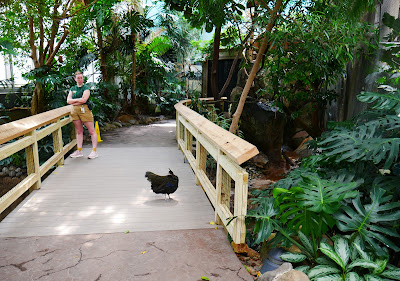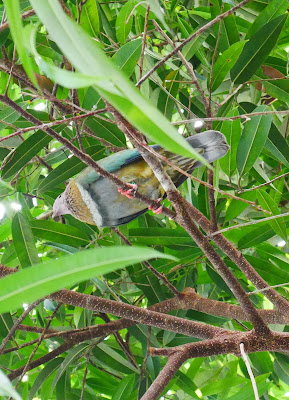When you first enter, you encounter a large arch revealing a jungle. What isn't readily apparent is the mesh netting on either side of the wide arch creating an enormous cage. In all my past visits a pair of Rhinoceros Hornbills resided there. On this visit, it appeared to be almost empty, save the lush plants and a single (what appeared to be) Blue-tailed Trogon.
IMPORTANT ASIDE: I wish I could have used the Zoo's website to confirm this, but honestly, post visit, I found the Philadelphia Zoo's website in regards to its animals the most pathetic and disappointing website I have ever encountered. They claim to be home to 1,900 animals, but you'll only find information on 19 there: that's 15 mammals, 2 birds, and 2 reptiles. They have a drop down that includes amphibians, but no examples. They have a search feature, but if you deviate from one of the nineteen present on the front page from the link, you will get the message "No Results Found". Now, maybe it's a work in progress, I don't know, because there is nothing anywhere on the page to suggest that more is coming at all.
From here you turn right and make a letter "C" that will take you through four aviaries (three sort of small) around to the back side of the arch and out again into the lobby on the opposite side. Since my last visit they'd replaced the open space with a thick close wire mesh in the first room. The effect makes it impossible to take photographs. The room is home to shore birds and a little flock of yellow weavers from Africa. The next space is the smallest and is subdivided into three areas. One for the Guam Kingfishers, another for the Guam Rail, and the third for a handful of little tropical Pacific Island song birds.
From here you enter the largest room where in the past I would count on observing around 10-12 species. On this visit, the place was rather quiet. I noted three species. I asked a keeper watching the room about one of them, but didn't inquire beyond that. It was a little disappointing. In the last room the set up is to look like a Central American Coffee Plantation. The signage educates guests on the relationship between the agricultural industry and the birds that exist on and around such farms. It's a nice set-up and there were half a dozen birds in the space, but the glare on the mesh netting made photography impossible here, too.
My overall impression was a bit of a letdown based on past experiences. I missed the Hornbills, as well as the Green Aracari and the Golden Pheasant that once called the large walk through aviary home.
From here you enter the largest room where in the past I would count on observing around 10-12 species. On this visit, the place was rather quiet. I noted three species. I asked a keeper watching the room about one of them, but didn't inquire beyond that. It was a little disappointing. In the last room the set up is to look like a Central American Coffee Plantation. The signage educates guests on the relationship between the agricultural industry and the birds that exist on and around such farms. It's a nice set-up and there were half a dozen birds in the space, but the glare on the mesh netting made photography impossible here, too.
My overall impression was a bit of a letdown based on past experiences. I missed the Hornbills, as well as the Green Aracari and the Golden Pheasant that once called the large walk through aviary home.
The spacious foyer with its tall, arched aviary. On the other side is the walk-through aviary.
VICTORIA CROWNED PIGEON
Goura victoria
Conservation Status: Near Threatened
The zookeeper with a ground bird in the walk-through aviary that I failed to identify.
BEAUTIFUL FRUIT DOVE
Ptilinopus pulchellus
Conservation Status: Least Concerned






No comments:
Post a Comment